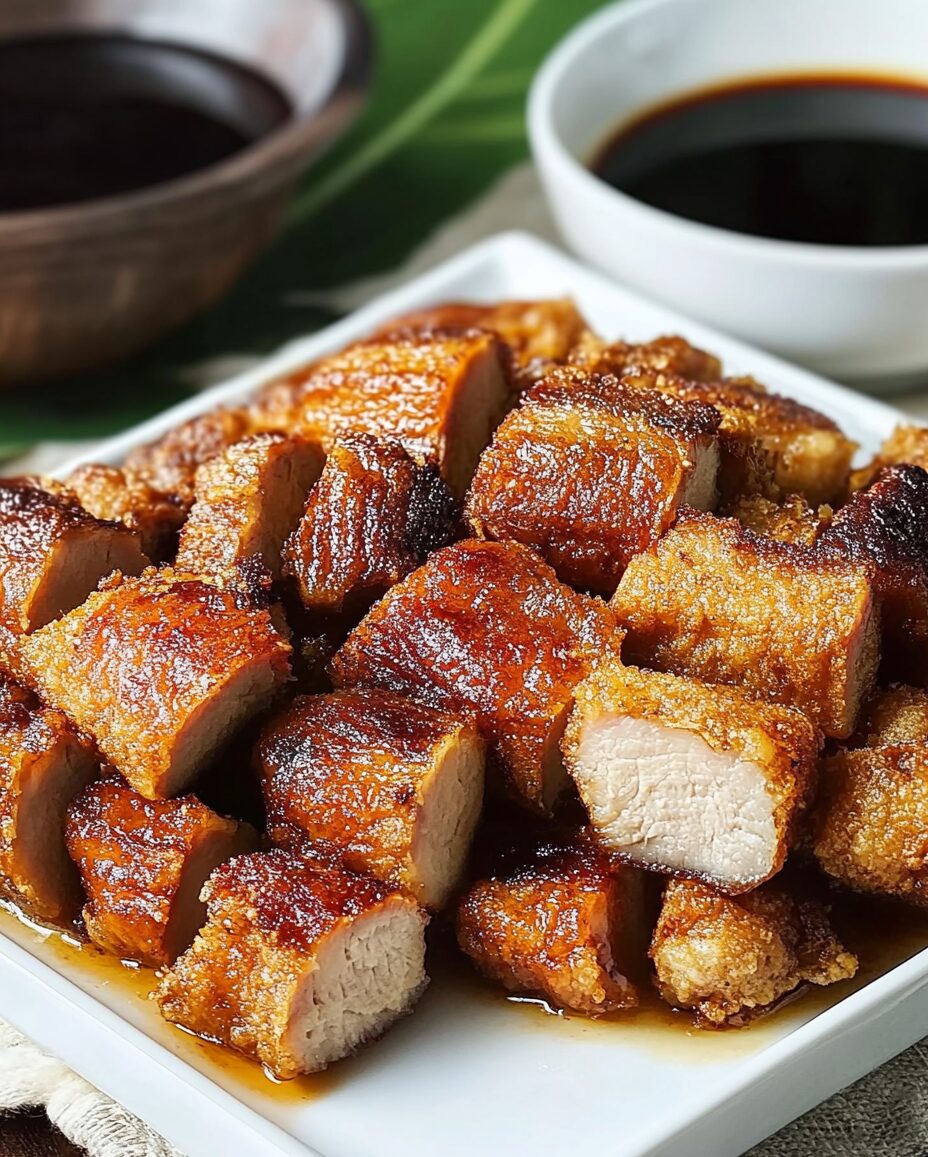Lechon Kawali is a popular Filipino dish featuring succulent pork belly fried to crispy perfection. The secret to its mouthwatering texture is simmering the pork until tender, then deep frying it for that signature crunch. It’s traditionally paired with a soy sauce and vinegar dipping sauce, making each bite burst with flavor.This hearty dish is loved for its simplicity and satisfying crunch, making it a great choice for family meals or gatherings. Serve it with steamed rice and your favorite vegetable sides for a complete and delicious experience that’s sure to impress!
Full recipe:
Ingredients:
-
- 2 lbs pork belly
- 4 cups water
- 1 tablespoon salt
- 1 tablespoon peppercorns
- 3 bay leaves
- 3 cloves garlic, crushed
- Vegetable oil for deep frying
- Soy sauce and vinegar dipping sauce (optional)
Directions:
- In a large pot, combine pork belly, water, salt, peppercorns, bay leaves, and garlic. Bring to a boil, then lower the heat and simmer for 45-60 minutes until the pork is tender.
- Remove the pork belly and let it cool. Pat it dry with paper towels.
- Heat oil in a large deep pan or fryer over medium heat. Once the oil is hot, carefully fry the pork belly in batches until the skin is crispy and golden, about 5-7 minutes per side.
- Remove the pork and drain excess oil on paper towels. Let it rest for a few minutes before slicing into bite-sized pieces.
- Serve with a side of soy sauce and vinegar dipping sauce, if desired.
Prep Time: 15 minutes | Cooking Time: 1 hour | Total Time: 1 hour 15 minutes
Kcal: 470 kcal | Servings: 4 servings
The Origins of Lechon Kawali
The word “Lechon” is derived from the Spanish word for “roasted suckling pig,” a dish introduced to the Philippines during Spain’s colonial period. Over time, Filipinos have adapted this culinary technique, evolving Lechon into various forms. Lechon Kawali, which translates to “fried Lechon,” simplifies the method by frying pork belly rather than roasting a whole pig. It’s typically fried until the skin is crackling, making it a more convenient alternative that can be enjoyed at home without the need for specialized equipment or extensive preparation.
Why Lechon Kawali Stands Out
1. Perfectly Balanced Texture One of the hallmarks of a great Lechon Kawali is its signature texture—crispy on the outside, tender and juicy on the inside. The pork belly, with its layers of fat and meat, renders perfectly when boiled and then deep-fried, offering a contrast of crunch and succulent pork goodness. The frying process locks in the moisture while crisping the skin, making each bite a delightful experience.
2. Simplicity and Versatility Lechon Kawali stands out due to its simplicity. It requires only a few basic ingredients—pork belly, salt, garlic, bay leaves, and peppercorns—making it an easy dish to prepare without sacrificing flavor. The ingredients are readily available, and the process is straightforward, yet it yields an impressive result. The dish is versatile enough to serve with a variety of sauces, such as a traditional soy sauce and vinegar mixture, or even with liver sauce, a popular Filipino condiment.
3. Customizable Dipping Sauces Lechon Kawali is often served with a variety of dipping sauces, enhancing its flavor. Soy sauce and vinegar mixed with garlic and chili is the most common dipping sauce, bringing a balance of salty, sour, and spicy notes that complements the richness of the pork belly. Some also enjoy pairing it with “sarsa” or liver sauce, which adds a sweet-savory dimension. These dipping options allow you to customize the dish to your personal taste, making each bite unique.
4. Nutritional Considerations Though Lechon Kawali is known for its indulgence, it does offer some nutritional benefits when consumed in moderation. Pork belly is a good source of protein and essential vitamins such as B12, B6, and minerals like zinc and iron. These nutrients play a role in boosting energy, supporting immune function, and maintaining healthy skin and nerve function. Additionally, pork belly contains a moderate amount of healthy fats, which provide energy and help in nutrient absorption.
To make the dish more health-conscious, you can pair it with vegetables such as steamed bok choy, sautéed spinach, or even a simple salad to balance the richness of the pork. Serving it alongside rice, as commonly done in Filipino cuisine, rounds out the meal, adding a neutral base that enhances the flavors without overpowering them.
Cooking Techniques for the Best Lechon Kawali
Achieving the perfect Lechon Kawali involves a two-step process: boiling and frying. First, the pork belly is boiled to tenderize the meat and infuse it with flavor from the aromatics like garlic, bay leaves, and peppercorns. Boiling ensures that the fat and skin are properly rendered, which will help create a crispy texture when fried. After boiling, the pork belly needs to cool down completely and be patted dry—this is crucial to ensure that the skin crisps up nicely in the frying step.
Frying is where the magic happens. Deep frying the pork belly in hot oil until golden brown creates that signature crunch. For home cooks, it’s essential to keep the oil temperature consistent; too hot, and the skin might burn before the inside is fully cooked; too low, and the pork won’t get crispy enough. Frying in batches also ensures even cooking. Finally, letting the pork belly rest before slicing helps retain its juiciness while allowing the skin to crisp further.
How to Serve Lechon Kawali
Traditionally, Lechon Kawali is served with a simple side of steamed white rice, a staple in Filipino meals. However, it pairs beautifully with a variety of other sides, including:
- Pickled vegetables (Atchara): The acidity of pickled papaya or carrots cuts through the richness of the pork, offering a refreshing contrast.
- Fresh salads: A light, crisp salad with cucumbers, tomatoes, and a simple vinaigrette adds brightness to the meal.
- Garlic fried rice (Sinangag): Garlic fried rice adds an extra layer of flavor to the dish, making it a heartier meal, especially for breakfast or brunch.
Lechon Kawali’s Role in Filipino Celebrations
Lechon Kawali is a go-to dish for many Filipino households during special occasions and family gatherings. It’s often served at fiestas, birthdays, and Christmas celebrations, where it sits proudly among other Filipino favorites like lumpia (spring rolls), pancit (noodles), and adobo. Its crunchy exterior makes it a crowd favorite, and it’s commonly the first dish to disappear from the table!
Unlike traditional Lechon, which requires a lot of preparation and is usually reserved for large parties, Lechon Kawali allows home cooks to bring the flavors of celebration into their daily meals. Even though it’s simpler to prepare, it doesn’t skimp on the flavor or festive feel.
Lechon Kawali in Modern Filipino Cuisine
As Filipino cuisine continues to gain global recognition, Lechon Kawali is often seen as a gateway dish for introducing international audiences to the rich culinary traditions of the Philippines. Many modern Filipino restaurants have elevated Lechon Kawali by serving it with gourmet twists, such as pairing it with fusion sauces or adding it as a topping to modern dishes like ramen or tacos.
Its simplicity, combined with its robust flavor and satisfying texture, makes Lechon Kawali a popular choice for those exploring Filipino food for the first time. Whether served traditionally with rice and dipping sauces or as a creative element in a contemporary dish, Lechon Kawali remains a beloved staple that showcases the heart of Filipino cooking—bold flavors, rich textures, and a celebration of good food shared with loved ones.
Why This Recipe Is the Best
This Lechon Kawali recipe excels because it balances ease of preparation with outstanding results. With just a handful of ingredients and simple techniques, anyone can achieve the golden, crispy exterior and melt-in-your-mouth tenderness that make this dish so irresistible. By following the recommended steps of boiling, cooling, and frying, you ensure that every piece of pork belly is perfectly cooked, with each bite offering a satisfying crunch.
Conclusion
The flexibility of this recipe allows you to experiment with different sauces and sides, making it adaptable to various palates. Whether you’re a seasoned cook or someone new to Filipino cuisine, this Lechon Kawali recipe guarantees a delicious and authentic taste of the Philippines in every bite.








